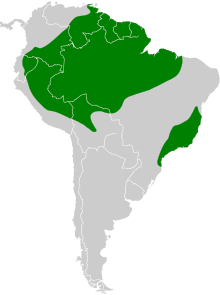Black-eared fairy
| Black-eared fairy | |
|---|---|

| |
| Scientific classification | |
| Kingdom: | Animalia |
| Phylum: | Chordata |
| Class: | Aves |
| Order: | Apodiformes |
| Family: | Trochilidae |
| Genus: | Heliothryx |
| Species: | H. auritus
|
| Binomial name | |
| Heliothryx auritus (Gmelin, 1788)
| |

| |
The black-eared fairy (Heliothryx auritus) is a species of hummingbird in the subfamily Polytminae, the mangoes. It is found in every mainland South American country except Argentina, Chile, Paraguay, and Uruguay.[2][3][4]
Taxonomy and systematics[]
The black-eared fairy and the purple-crowned fairy (H. barroti) were treated as conspecific by some authors but are now considered to be a superspecies; they are the only members of the genus.[5] Three subspecies are recognised, the nominate H. a. auritus, H. a. auriculatus, and H. a. phainolaemus.[2]

Description[]
The black-eared fairy is 10.1 to 13.7 cm (4.0 to 5.4 in) long and weighs 4 to 6.3 g (0.14 to 0.22 oz). The nominate male has bright shiny green upperparts, pure white underparts, and a long pointed tail which has darkish blue central and white outer feathers. It has a black patch below the eye, glittering purple ear coverts, and a short, straight, black bill. The female is similar but has no purple on the face, its throat and breast have grayish dots, and the three outer pairs of tail feathers have a black band at their base. Immatures have cinnamon fringes on their upperparts' plumage and are otherwise similar to the female. The male H. a. auriculatus has green on the chin and the sides of its throat. The male H. a. phainolaemus has a varible green throat and chin and the female does not have the noninate's gray spots on the underparts.[6]
Distribution and habitat[]
The nominate subspecies of black-eared fairy is found from southeastern Colombia and eastern Ecuador through northern Brazil north of the Amazon River to northeastern Venezuela and through the Guianas. H. a. phainolaemus is found in the Brazilian states of Pará and Maranhão south of the Amazon. H. a. auriculatus has two separate populations. One is in eastern Peru, central Bolivia, and central Brazil south of the Amazon as far east as the Tapajós River. Its other population is in southeastern Brazil from Bahia south to São Paulo (state) and irregularly further south. The species inhabits the interior and edges of wet primary and secondary forest. In elevation it is most common below 400 m (1,300 ft) but it occurs as high as 800 m (2,600 ft).[6]
Behavior[]
Movement[]
The black-eared fairy is believed to be sedentary, but some irregular movements have been reported in southern Brazil.[6]
Feeding[]
The black-eared fairy mostly forages in the mid-story and canopy, though in terra firme forest it will forage at all levels. It takes nectar from a variety of flowering plants, both by inserting its bill into the corolla and by piercing the base of the flower to "rob" nectar. It also feeds on small insects on the wing, unlike the purple-crowned fairy.[6]
Breeding[]
The black-eared fairy breeds throughout the year. The female alone builds the nest, incubates the eggs, and cares for the young. It makes a small cup nest of plant down on a vertical branch, usually between 3 and 30 m (9.8 and 98 ft) above the ground. The clutch size is two eggs. The incubation time is 15 to 16 days with fledging 23 to 26 days after hatch. It breeds for the first time when in its second year.[6]
Vocalization[]
The black-eared fairy's calls include "a short high-pitched 'tsit' and richer 'tchip', repeated at intervals."[6]
Status[]
The IUCN has assessed the black-eared fairy as being of Least Concern, though its population size is not known and believed to be decreasing.[1] It has a very large range, is considered fairly common in parts of it, and occurs in several protected areas.[6]
References[]
- ^ a b BirdLife International (2016). "Black-eared Fairy Heliothryx auritus". IUCN Red List of Threatened Species. 2016: e.T22688111A93182732. doi:10.2305/IUCN.UK.2016-3.RLTS.T22688111A93182732.en. Retrieved 15 December 2021.
- ^ a b Gill, F.; Donsker, D.; Rasmussen, P. (July 2021). "IOC World Bird List (v 11.2)". Retrieved July 14, 2021.
- ^ HBW and BirdLife International (2020) Handbook of the Birds of the World and BirdLife International digital checklist of the birds of the world Version 5. Available at: http://datazone.birdlife.org/userfiles/file/Species/Taxonomy/HBW-BirdLife_Checklist_v5_Dec20.zip [.xls zipped 1 MB] retrieved May 27, 2021
- ^ Remsen, J. V., Jr., J. I. Areta, E. Bonaccorso, S. Claramunt, A. Jaramillo, D. F. Lane, J. F. Pacheco, M. B. Robbins, F. G. Stiles, and K. J. Zimmer. Version 24 August 2021. Species Lists of Birds for South American Countries and Territories. https://www.museum.lsu.edu/~Remsen/SACCCountryLists.htm retrieved August 24, 2021
- ^ Remsen, J. V., Jr., J. I. Areta, E. Bonaccorso, S. Claramunt, A. Jaramillo, D. F. Lane, J. F. Pacheco, M. B. Robbins, F. G. Stiles, and K. J. Zimmer. Version 24 August 2021. A classification of the bird species of South America. American Ornithological Society. https://www.museum.lsu.edu/~Remsen/SACCBaseline.htm retrieved August 24, 2021
- ^ a b c d e f g Schuchmann, K.L., G. M. Kirwan, and P. F. D. Boesman (2020). Black-eared Fairy (Heliothryx auritus), version 1.0. In Birds of the World (J. del Hoyo, A. Elliott, J. Sargatal, D. A. Christie, and E. de Juana, Editors). Cornell Lab of Ornithology, Ithaca, NY, USA. https://doi.org/10.2173/bow.bkefai1.01 retrieved December 15, 2021
| Wikimedia Commons has media related to Heliothryx auritus. |
- IUCN Red List least concern species
- Heliothryx
- Birds of the Amazon Basin
- Birds of the Guianas
- Birds of the Atlantic Forest
- Birds described in 1788
- Taxa named by Johann Friedrich Gmelin
- Birds of Brazil

